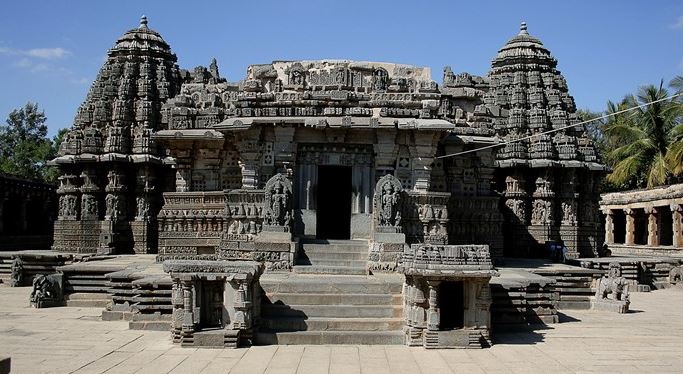From UPSC perspective, the following things are important :
Prelims level: Keshava Temple, Somanathapura; Hoysala Architecture.

Why in the News?
- Karnataka’s Tourism Department plans to highlight Somanathapura Temple, part of the Hoysala temples, in the Mysuru tourism circuit ahead of Dasara, leveraging its UNESCO World Heritage status.
- The Somanathapura Temple, along with other Hoysala temples such as the Chennakeshava Temple at Belur and the Hoysaleshwara Temple at Halebid, (called ‘Sacred Ensembles of the Hoysala’) was granted UNESCO WHS in September 2023.
| Note: There are 42 World Heritage Sites in India. Out of these, 34 are cultural, seven are natural, and one, Khangchendzonga National Park, is of mixed type. |
About Keshava Temple, Somanathapura
- The Keshava Temple is considered one of the last grand structures built by the Hoysala dynasty.
- This Trikuta (three-shrined) temple is dedicated to Lord Krishna and is represented in three forms: Janardhana, Keshava, and Venugopala.
- The main Keshava idol is missing, and the Janardhana and Venugopala idols are damaged.
Historical Background:
- The Keshava Temple was constructed by Somanatha, a commander of the Hoysala Army, during the reign of Hoysala King Narasimha III.
- Somanatha, who had established a town named Somanathapura after himself, sought the king’s permission and resources to build this grand temple.
- With the king’s blessing, construction commenced and was completed in 1268 AD.
- An inscription in old Kannada on a stone slab in the temple provides details of its construction and consecration.
- After demolitions by invaders, it no longer serves as a place of worship.
Architecture:
- The temple is constructed from soapstone, which allows for the fine detailing seen in the carvings.
- It is built on a raised platform with an outer Pradakshina pathway, allowing devotees to circum-ambulate the sanctum.
- The temple features a stellar (star-shaped) plan, which creates multiple corners and niches, providing numerous canvases for the sculptors to showcase their intricate work.
- The temple has three shrines, each crowned with a Vimana (tower).
- The Hoysala emblem, depicting a warrior fighting a lion, is prominently displayed.
- The walls of the temple are adorned with beautiful friezes depicting scenes from Hindu epics, figures of elephants, and battle scenes with cavalry.
Tap to read more about:
PYQ:[2019] Building ‘Kalyana Mandapas’ was a notable feature in the temple construction in the kingdom of (a) Chalukya (b) Chandela (c) Rashtrakuta (d) Vijayanagara [2012] The Nagara, the Dravida and the Vesara are the: (a) three main racial groups of the Indian subcontinent (b) three main linguistic divisions into which the languages of India can be classified (c) three main styles of Indian temple architecture (d) three main musical Gharanas prevalent in India [2013] Chola architecture represents a high watermark in the evolution of temple architecture. Discuss. |
Get an IAS/IPS ranker as your 1: 1 personal mentor for UPSC 2024

